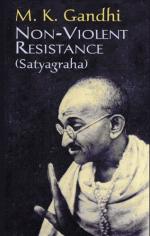|
This section contains 796 words (approx. 2 pages at 400 words per page) |

|
Satyagraha
Satyagraha literally means "holding firmly to the truth" in Sanskrit. It is the philosophy and practice of nonviolent resistance that Gandhi developed throughout his social activism. Satyagraha was used by Gandhi in fights against the injustices perpetrated on the Indian people by the British government and to fight for Indian independence from Britain.
For Gandhi, Satyagraha is the force of the truth; it is a form of active resistance that seeks not to get what one wants for oneself but to convert the opponent into another being of love. Gandhi does not think that the idea of Civil Disobedience fully expresses the idea of Satyagraha. It is the pursuit of truth that lies at the heart of Satyagraha and it also prevents inflicting violence. Satyagraha requires convincing the other of the truth through non-coercive means and self-suffering. One inflicts the suffering of falsehood on oneself to show the...
|
This section contains 796 words (approx. 2 pages at 400 words per page) |

|




